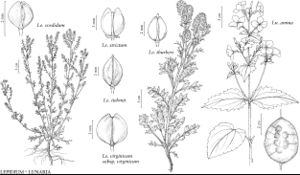Lunaria
Sp. Pl. 2: 653. 1753.
Gen. Pl. ed. 5, 294. 1754.
Plants not scapose; pubescent, glabrate, or glabrous. Stems erect, unbranched or branched distally. Leaves basal and cauline; petiolate or sessile; basal (soon withered, opposite), rosulate, long-petiolate, blade margins coarsely dentate; cauline (opposite or alternate), petiolate or (distal) sessile, blade margins coarsely dentate. Racemes (corymbose, several-flowered, rarely proximalmost flowers bracteate), considerably elongated in fruit. Fruiting pedicels divaricate or ascending, slender. Flowers: sepals cucullate, (median pair) linear or (lateral pair) broadly oblongelliptic; petals obovate, (much longer than sepals), claw strongly differentiated from blade, (nearly as long as sepal, apex obtuse); stamens tetradynamous; filaments usually not dilated basally (or slender); anthers oblong or linear, (apex obtuse); nectar glands lateral, annular or semiannular. Fruits (often pendulous), long-stipitate [rarely subsessile], oblong to suborbicular [orbicular, lanceolate-elliptic], not torulose, strongly latiseptate; valves each not veined, glabrous; replum rounded; septum (persistent), complete, (broad, shiny); style slender; stigma capitate, 2-lobed (lobes opposite replum, connivent or not). Seeds strongly flattened, broadly winged [not winged], reniform [orbicular]; seed-coat not mucilaginous when wetted; cotyledons accumbent. x = 15.
Distribution
Introduced; Europe, also in s South America
Discussion
Species 3 (1 in the flora).
Two species of Lunaria are ornamentals cultivated worldwide; L. annua often escapes from cultivation.
Although R. C. Rollins (1993) listed Lunaria rediviva Linnaeus as “rarely found in long persisting populations outside of cultivation,” I have not seen any material that unequivocally proves that the species is naturalized in North America. It is easily distinguished from L. annua by being perennial with petiolate distalmost leaves and elliptic-lanceolate fruits acute at base and apex. By contrast, L. annua is biennial or, rarely, annual and has sessile distalmost leaves and suborbicular to broadly oblong fruits obtuse at base and apex.
Selected References
None.
Lower Taxa
"elongated" is not a number."thick" is not a number.
